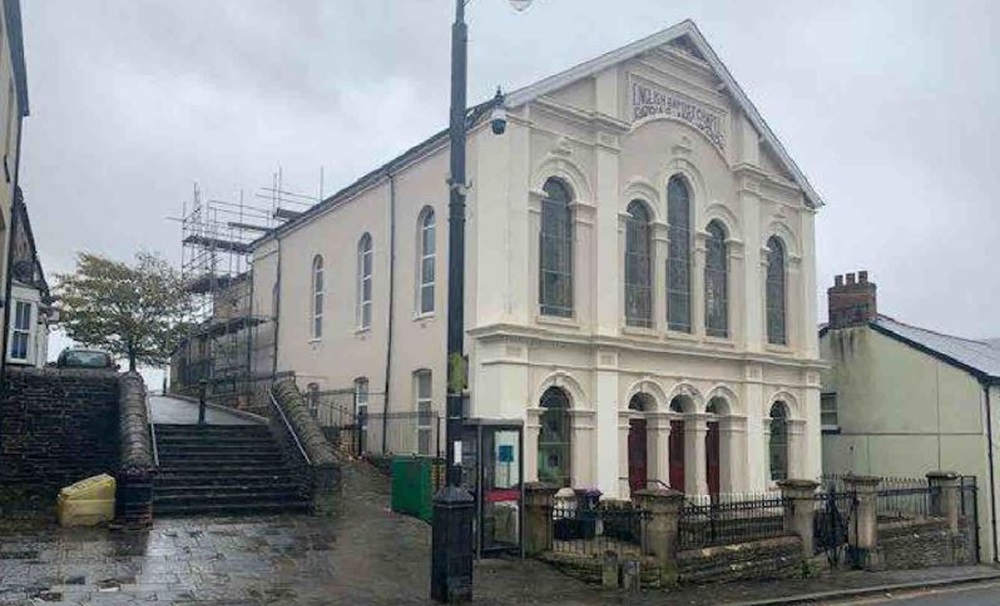Plans approved to repair chapel built by English migrants

Twm Owen, local democracy reporter
A plan to repair water damage to a chapel built by English migrants who flocked to Wales during the industrial revolution has been agreed.
Moriah Chapel, on Broad Street, which is Blaenavon’s commercial centre, was granted Grade II-listed status by Welsh historic buildings body Cadw in 1995 as “a prominent later 19th century town centre chapel”.
Five years later the town was recognised as a World Heritage Site by United Nations body UNESCO due to its importance to the development of mining and ironmaking industries in the late 18th and early 19th centuries.
A painted inscription panel, centred and towards the top of the chapel’s façade, reads “English Baptist Chapel AD 1888”.
Damp issues
A heritage report, prepared on behalf of the chapel, said “significant damp issues have been a concern for some time” on the side wall of the chapel which is next to a shop, that was once the Sunday School, and is visible from the street.
Torfaen Borough Council’s planning department has agreed to the plans put forward to remove the existing pebbledash finish from the wall and replace it with a lime render. Work to clear blocked guttering and repair an overflowing downpipe will also be carried out.
London-based charity the Victorian Society, which aims to protect Victorian and Edwardian buildings, said it has no objection to the planned work.
Lime render
Planning officer Rebecca McAndrew said lime render would be “an improvement which would not affect the significance of the building” and “an enhancement to the overall vistas within the town conservation area and World Heritage Site.”
Her report also said the chapel serves the community and its preservation will ensure it continues to have a viable use.
The heritage impact statement explained the chapel was first known as Blaenavon Evangelical Church and established in a “somewhat humble” building in Broad Street by English Baptists in 1844 but rebuilt in its current “much grander, classical form” in 1888.
The report stated: “An increasing number of migrants, seeking employment in Blaenavon in the nineteenth century, came from the counties of England and could not speak the Welsh language so it became necessary for English-speaking nonconformists to form their own chapels.”
2011 Census data, shared by Torfaen council, showed just 581 people or 9.98 per cent of Blaenavon’s population could speak Welsh.
Support our Nation today
For the price of a cup of coffee a month you can help us create an independent, not-for-profit, national news service for the people of Wales, by the people of Wales.







Welsh chapels are allowed to deteriorate but an English one is preserved!!
Why don’t you gutless thumbs down heroes leave a comment to back up your action?
It’s not an English chapel if it’s in Blaenafon.
The could have just learned Welsh though, couldn’t they?
Good to see that some remedial work is to be caried out on a building of some historic significance. Who is paying for it? Who owns it? After all the report only says that the plans have been approved presumaby by the Planning Dept. If Welsh chapels of similar historic significance need attention lets hear about them and get them fixed. Crowd funding is not that difficult to set up. The difficult bit is to get the revenue stream afterwards to keep up with maintenance. The mining and other industrial chapels have gone into decline because the jobs have gone… Read more »
Er…BlaenaFon
Blaenavon was in Monmouthshire until 1974. Monmouthshire had been under English administration since the 16c.
Monmouthshire only became a county of Wales in 1972.
The chapel may have been built by English speakers but they were not migrants and they had not ‘flocked to Wales’ merely moved to Monmouthshire.
Perhaps use your local history correspondent next time